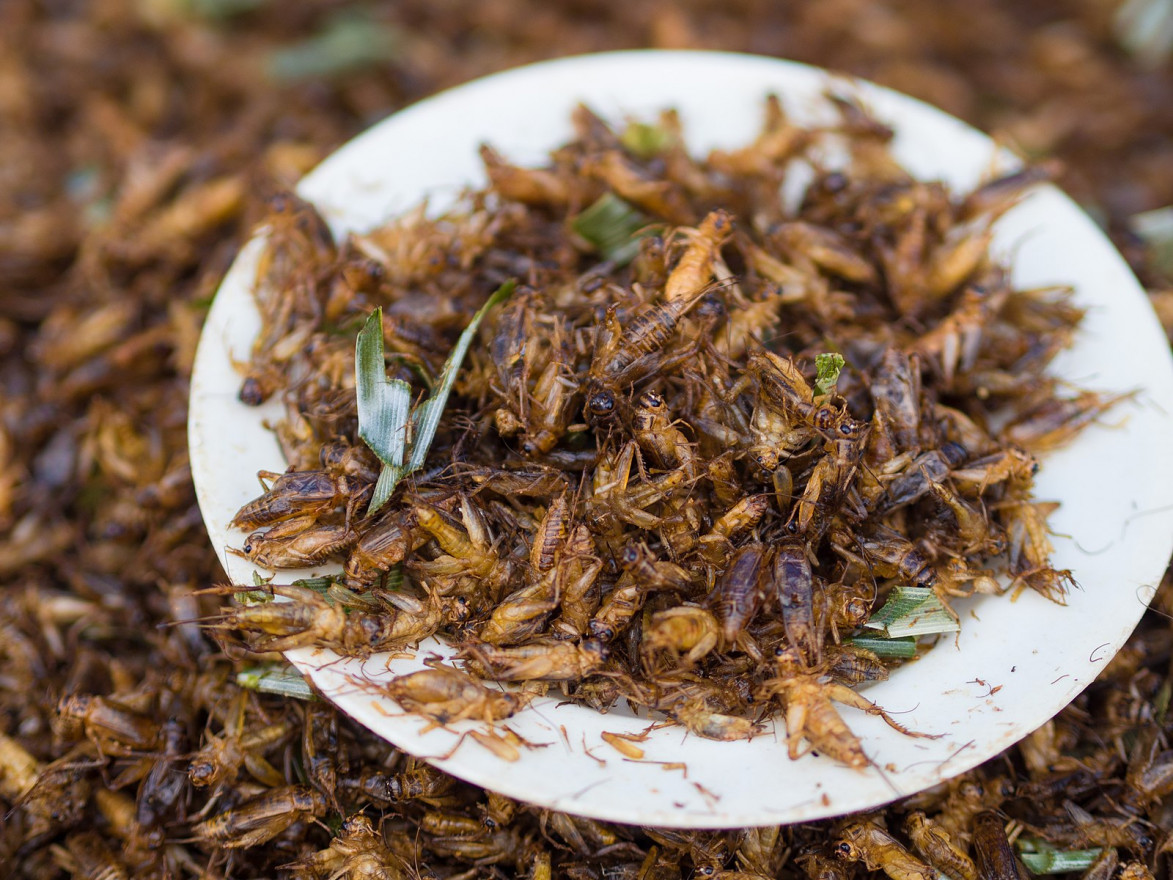
Deep-fried crickets are a common snack in Thailand. (Takeaway/Wikimedia Commons)

Deep-fried crickets are a common snack in Thailand. (Takeaway/Wikimedia Commons)
Food resources face challenges in a variety of ways, from climate change affecting global warming to interruptions in production as a result of COVID-19. A rising middle-class in the United States and a growing appetite for Western cuisine have increased demand for meat-based diets. Between the land it takes to raise livestock, to the technology required for commercially catching fish and a rise in temperatures across the globe that threatens agriculture, scientists are exploring new alternatives for food. Some have suggested crickets, seaweed, and cultured meats as sustainable food options that could one-day stock the shelves of grocery stores across the United States.
Rick Weiss, the director of SciLine – an editorially independent, nonpartisan, nonprofit publication service for journalists and scientists – moderated a panel diving into the “future of food.” Three experts on the subject spoke about the possibilities that roam beyond typical farming strategies that are more sustainable for the environment and potentially healthier for humans as well.
Dr. Julie Lesnik, an assistant professor in the department of anthropology at Wayne State University, discussed the potential for mass-produced “edible insects” like crickets. Crickets produce high levels of protein and even greater levels of calcium and iron compared to pigs and cows. These figures could vary depending on what a farmer feeds their livestock, Lesnik said. But overall, insects pack high amounts of nutrients.
Large-scale farms producing a single crop depend on high amounts of fossil fuels, pesticides, and antibiotics, according to Healthcare Without Harm. Cows are placed in tight, cramped spaces on farms in order to produce as much meat as possible. This method, in which cows are raised for human consumption, raises concerns about the ethics of mass-producing meat, Lesnik said. But crickets like close-knit spaces.
“Crickets already like dark, cramped spaces, and so they produce well. They’re happy in those spaces,” Lesnik said.
Many countries already eat crickets and other insects but the U.S. has built up a stigma against them. Lesnik said this stigma stems from colonial America when Spanish sailors, like Christopher Columbus’ crew members, saw indigenous tribes eating bugs and viewed the behavior as “beastly.”
“If we’re going to change this attitude, we’ve got to change this idea of it as primitive and savage and allow younger generations to view insects differently and make this food source available to them,” Lesnik said.
Dr. Kate Krueger is a cell biologist and research director at New Harvest – a nonprofit research institute that supports innovations in cultured meat and cellular agriculture. During Krueger’s introduction to the panel, SciLine’s Weiss shared “how impossible burgers are, in fact, possible,” given the research Krueger has conducted.
She discussed the potential for cellular agriculture to substitute meat farming. Cellular agriculture requires cells to be taken out of an organism, like a cow, and then grown onto a material called a scaffold. A scaffold allows the cells to grow up and be fed with nutrients and minerals in a bioreactor to make a steak-like product. Technology for a steak-like product is at least 10 years away from coming to fruition, but products like meatballs, chicken nuggets, and burgers are closer to 5 years from creation, Krueger said.
However, the evolution of cellular technology is raising concerns for meat and poultry farmers.
“There’s often kind of a push-pull in the field between a lot of enthusiasm about these new products and a lot of potential pushback from different people who grow these animals,” Krueger said.
The veganism movement, fueled by younger generations, has shown the benefits of meat alternatives. But if the world stopped eating meat altogether, serious economic and health repercussions would arise for millions of people, specifically in rural populations. Many people rely on a meat-based diet to consume enough protein at cheaper prices. Sources like beans and rice would not cut it, experts shared at the World Economic Forum.
Dr. Denise Skonberg, associate professor of food science in the Food and Agriculture School at the University of Maine, studies the benefits seaweed and algae can have on a human diet and the environment. Her research focuses on the health benefits of seafood products like marine organisms.
“There are thousands of species of seaweeds,” Skonberg said, “and they vary a lot in terms of their appearance, their color, their nutritional value, their texture, and their flavor.”
.jpeg)
She said the growing “foodie” movement in the United States – a movement that has sparked new types of cuisine – leads her to believe large-scale seaweed production would benefit the economy. The global seaweed economy amounted to $6 billion in 2018, mostly produced in China. Skonberg said the warm waters on the east and west coasts could make ideal places for larger seaweed farms.
However, the warming ocean temperatures raise a concern for the sustainability of these potential farms. Skonberg said scientists are currently studying the genetic diversity of various kinds of seaweed and testing where various types of seaweed thrive in various climates.
The bottom line for all three experts? More research is needed. Sustainable farming for crickets, cultured meats, and seaweed needs more engineering investment to understand if these options can help sustain humans and better the environment. However, all three experts stressed that the possibilities are out there for sustainable food, like increased health benefits for humans.
Now the funding and technology efforts must come together to make it happen.